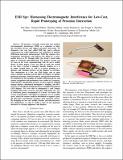EMI Spy: Harnessing electromagnetic interference for low-cost, rapid prototyping of proxemic interaction
Author(s)
Zhao, Nan; Dublon, Gershon; Gillian, Nicholas; Dementyev, Artem; Paradiso, Joseph A.
Downloademi-spy-harnessing.pdf (2.165Mb)
OPEN_ACCESS_POLICY
Open Access Policy
Creative Commons Attribution-Noncommercial-Share Alike
Terms of use
Metadata
Show full item recordAbstract
We present a wearable system that uses ambient electromagnetic interference (EMI) as a signature to identify electronic devices and support proxemic interaction. We designed a low cost tool, called EMI Spy, and a software environment for rapid deployment and evaluation of ambient EMI-based interactive infrastructure. EMI Spy captures electromagnetic interference and delivers the signal to a user's mobile device or PC through either the device's wired audio input or wirelessly using Bluetooth. The wireless version can be worn on the wrist, communicating with the user;s mobile device in their pocket. Users are able to train the system in less than 1 second to uniquely identify displays in a 2-m radius around them, as well as to detect pointing at a distance and touching gestures on the displays in real-time. The combination of a low cost EMI logger and an open source machine learning tool kit allows developers to quickly prototype proxemic, touch-to-connect, and gestural interaction. We demonstrate the feasibility of mobile, EMI-based device and gesture recognition with preliminary user studies in 3 scenarios, achieving 96% classification accuracy at close range for 6 digital signage displays distributed throughout a building, and 90% accuracy in classifying pointing gestures at neighboring desktop LCD displays. We were able to distinguish 1- and 2-finger touching with perfect accuracy and show indications of a way to determine power consumption of a device via touch. Our system is particularly well-suited to temporary use in a public space, where the sensors could be distributed to support a popup interactive environment anywhere with electronic devices. By designing for low cost, mobile, flexible, and infrastructure-free deployment, we aim to enable a host of new proxemic interfaces to existing appliances and displays.
Date issued
2015-06Department
Massachusetts Institute of Technology. Media LaboratoryJournal
2015 IEEE 12th International Conference on Wearable and Implantable Body Sensor Networks (BSN)
Publisher
Institute of Electrical and Electronics Engineers (IEEE)
Citation
Zhao, Nan, Gershon Dublon, Nicholas Gillian, Artem Dementyev, and Joseph A. Paradiso. “EMI Spy: Harnessing Electromagnetic Interference for Low-Cost, Rapid Prototyping of Proxemic Interaction.” 2015 IEEE 12th International Conference on Wearable and Implantable Body Sensor Networks (BSN) (June 2015), Cambridge, MA. pp.1-6.
Version: Author's final manuscript
Other identifiers
INSPEC Accession Number: 15525176
ISBN
978-1-4673-7201-5